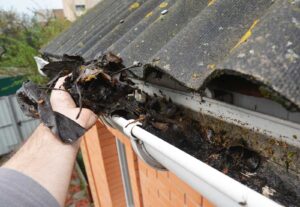How to Perform Proper Rain Gutter Cleaning in the Fall
They play an integral role in protecting your home and its foundation from water damage. Gutters work to divert water away from vulnerable areas of your home, such as the roof, fascia boards, walls, and more. The popular time for cleaning your gutters is the transition between spring and summer, but what’s more important than timing is tools and technique.
Keep reading to learn more about how to clean gutters, what supplies you’ll need, and the best techniques for doing it safely and effectively.
Here Are the Tools You’ll Need
Here’s a list of the tools you’ll need for DIY gutter cleaning. It’s a tedious and infrequent task that many homeowners may find they don’t care to do again after trying it. It’s best for the first time to either buy inexpensively or see if you can borrow a friend’s tools to be sure that you’ll want to tackle this project again in the future.
Use Eyewear Protection
Wearing protective eyewear and thick work gloves are essential for cleaning gutters. You may come into contact with animal feces and litter in your gutter. So practice safe sanitation precautions by wearing gloves.
Eyewear will protect your eyes from blowing debris and tiny bits of decomposed leaves that are hanging out in your gutters.
Wear Thick Work Gloves
Twigs, briars, and other sharp debris might be clogging your gutters, so it’s best to use a thicker pair of gloves for this task. Simple work gloves or gardening gloves likely aren’t up for the task.
Instead, look for rubber gloves or leather work gloves designed for handling harsh materials.
Invest in a Heavy Duty Bucket
It’s tempting to toss the debris on the ground when cleaning gutters, but simply keeping a bucket with you can avoid extra time picking up sodden leaves and debris afterward. You’ll likely be tired, and an extra hour that was easily avoidable may not be something you want to devote time to.
Select a bucket that’s durable, but lightweight and with a good handle. As your bucket accumulates material from your rain gutters or as you clean your downspouts, it’ll weigh more. It’s important that the bucket is sturdy enough to accommodate excess weight without adding to it.
Get a Good Scoop
Attempts at a Jeopardy pun aside, a simple scoop is also a good tool to have on hand when you’re cleaning your gutters. Using tired and aching fingertips to gouge out questionable material is not always something homeowners (or anyone) want to do.
We don’t encourage you to use one you plan to handle food with afterward, but a rounded, metal scoop is a good choice. Plastic scoops aren’t as durable and while using any kind of scoop does increase the risk of damage to your gutter system, a rounded edge helps negate some of that risk.
You’ll Need a Ladder
You will need a stable extension ladder that can extend three feet above the height of your gutters. A regular 4-legged ladder or step-ladder is not appropriate for this job.
Gutters are not made to withstand weight on them. Never lean or rest a ladder on the gutter. That will cause your ladder to damage the gutter and could result in you falling off the ladder.
➡️Pro Tip: Check that there aren’t any electrical wires before positioning your ladder. Ladders should always be 10 feet away from power lines. Never touch an overhead powerline. They are not insulated to prevent electrical shocks.
Consider a Pressure Washer and Wand
While we don’t recommend using a pressure washer without the guidance of a professional—not all homes and surfaces are meant to be pressure washed—if it’s something you’ll be using to clean your gutters, you can do it safer with the use of a wand.
When using a pressure washer to clean your gutters, be sure that you only use the pressure necessary and that won’t damage your gutters. You can determine that by starting at the lowest pressure and slowly build up pressure until you can clear clogs without threatening the integrity of your gutters. (Nervous? Get a free quote so that professionals can do it for you.)
If you are using a pressure washer, consider getting a brush attachment. While it may not be as effective as doing it by hand, It’s safer than getting on a ladder.
A Leaf Blower Works Well For Cleaning Downspouts
Using a leaf blower and a gutter attachment is a good alternative to investing in a pressure washer that you’ll rarely use. Many homeowners have leaf blowers already and find it a good rule of thumb to use them to clean gutters when they clear away fallen leaves at the end of autumn.
Look for a gutter attachment at local hardware stores and be sure that it is a universal fit that will work with your leaf blower.
Use A Sponge and Spray Solution
While the hard part is done, it’s important to not forget one final step: clean up the exterior of your gutters. A simple sponge and spray bottle with a cleaning solution can be used to clean a gutter system’s outside walls and get the job done. For those working on a ladder, reduce the risk of a fall and consider working in sections. You won’t have to get on the ladder more than once for the same area.
Stey by Step Guide: Cleaning Your Gutters
By now, you know that routine rain gutter cleaning can save you thousands of dollars in costly home repairs when compared to the cost of a professional service. Here is a step-by-step guide that answers the question of how to clean your gutters, or how to clean downspouts, and what all is involved with this home maintenance chore.
1. Debris Removal
First thing’s first, you’ll need to assess the build-up of debris, ice dams, and dirt in your gutters, and remove it all. Start at the drain outlet and use a garden trowel or gutter scoop to gather loose debris. Then, scoop the debris into a plastic bucket to make cleaning up simple. Move your ladder as necessary to scoop out the full length of the gutter.
2. Nest and Pest Removal
Gutter systems make for the perfect cozy perch for small critters such as birds, rats, and other pests during the cold of winter. But by the time spring and summer comes around, nesting birds will have most likely fled and left empty nests behind. You’ll need to check for empty bird’s nests and any other sign of life and remove them accordingly.
Wasp nests are also fairly common in and amongst gutter systems. If these nests are still inhabited, a pest control company should be enlisted for their removal.
3. Gutter Scrub Down
Once all debris, nests, and pests have been sufficiently removed from your gutters, it’s time for a thorough scrub down. Using a high-pressure hose, wash the hose out with the hose always pointed toward the drain outlet. This part can get muddy as there will be hardened dirt that has become stuck to the bottom of the gutter.
After gutters have been thoroughly cleaned, move to the downspouts, which are an integral part of your home’s guttering system. You’ll need to scoop out any debris you can reach and flush the downspouts with a garden hose.
For any moss, algae, or other build-ups, you may need to use a scrub brush and gentle abrasive or soap. If certain areas are particularly stubborn when it comes to grime removal, this could point to a drainage problem and a specialist will be referred.
➡️Pro Tip: If you need to use a stiff brush or a metal spoon to loosen some of the dirt, be careful to not be too forceful; depending on the type and age of your gutters, you could cause damage.
4. Damage Assessment
After your gutters are clean and free from any debris, it’s easier to identify areas of serious decay and damage. Look for any clogs or obstructions in the downspouts. You can run your hose directly into the spout to look for a blockage. Gently tapping the side of the spout as you run the hose through it may help loosen up clogs. This is also when you will be assessing your downspouts for any wear and tear or damage.
If water still isn’t draining freely, you can use a plumbing auger to loosen a clog. Push the snake up the pipe from the bottom to pull the trapped debris loose. You may need to repeat this from the top of the drainpipe as well.
5. Roof Clean and Assessment
Once all necessary cleaning is complete, you will need to give your roof a thorough once-over as well. Be sure to clear your roof of any debris build-up such as branches, leaves, and dirt to get a clear idea of any damage. Damage might include:
- Loose or missing shingles. This damage can cause leaks and pooling water to stand and clog your gutters, which could eventually lead to a nasty pest infestation.
- Damaged fascia boards. If these are damaged, this could cause gutters to sag and eventually fall from your roof.

- Rust and loose gutters. Depending on the age and material of your gutters, you may need to look for signs of rust. Also, watch for loose brackets or other hardware designed to hold your gutters in place.
Any obvious areas of damage on your roof will require a contractor; we don’t recommend roof repair as a weekend DIY project.
6. Long-Term Gutter Projects
While not really a DIY project, for severely damaged gutters we recommend planning long-term projects to enhance your property. Summertime and warmer months are great for a full gutter replacement in the event that damage is significant or contracting professionals for the right type of gutter guards for your roof.
Things to Keep in Mind
You’ll want to be mindful of a few things both for your safety and to reduce work later after the most tedious parts of gutter cleaning have been completed.
- First, be careful with the mud.
- Getting mud splatter onto your windows and exterior walls creates more work and you will have to spend even longer cleaning up after clearing out the gutters.
- Second, how high are the gutters?
- Over 28,000 people are injured each year by falling off of ladders in home cleaning projects. If your house is tall (such as a 2-story home with a walkout basement) or if you’re afraid of heights, it’s best to leave this particular chore to the experts.
- Lastly, how close are your gutters to power lines?
- If your gutters sit less than 10 feet from power lines, you should not attempt to do rain gutter cleaning yourself. The risk of electrocution is just too great.
If you are at all uncomfortable attempting this fall gutter maintenance task or if you have health conditions that make you susceptible to the debris that can build up, don’t clean your own gutters; hire professional gutter cleaners instead.
➡️Pro Tip: Not all professionals are equal. Ask any exterior cleaning service these seven questions to determine if they are a good fit for your needs and budget.
If you’re looking for professional gutter cleaning, you’ve come to the right place with Labor Panes. We offer an assortment of high-quality services, such as gutter cleaning, polishing, and gutter guards, to prepare your property for any weather and keep it looking its best.
Find your nearest location and contact us for your free gutter cleaning quote today. Then, rest easy: Your gutters won’t cause your headaches this year.
Take a look at this gutter. The left side has been polished and looks brand new, while our professionals haven’t gotten to the right side yet.

Frequently asked questions about gutter cleaning
How to clean your gutters isn’t as straightforward as most people think. Here are the most commonly asked questions we see for DIY gutter cleaning.
What is the best way to clean the outside of gutters?
The most effective and safe way to clean the outside of your gutters is with a soft wash. This keeps your feet safely on the ground and uses gentle cleansing agents, plus a moderate amount of force, to remove dirt and build-up from your gutter system.
How to clean your gutters yourself?
While we don’t recommend cleaning your own gutters, the best way to do it is to have a friend help with support, if you need a ladder, and to gather the right tools and supplies before you start. Begin with removing any clogs from the gutter system, flushing the system of any further debris, and then clean the outside of your gutters.
What is the best cleaner to use on gutters?
This really depends on the type of material your gutters are made from, but generally speaking plain white vinegar from the store is safe for most surfaces and a safer choice for landscaping. With metal, however, you’ll want to wash it off quickly to avoid corrosion.
How do you clean gutters step by step?
First, assemble and organize your tools. Second, use said tools to unclog your gutter system and then flush the gutters and downspouts. Once that is done, repair any damage you can and then clean the exterior of your gutters. If your gutters or roof is in serious disrepair, a final step may be needed. You may have to call in a professional service to do repairs or replacements.










